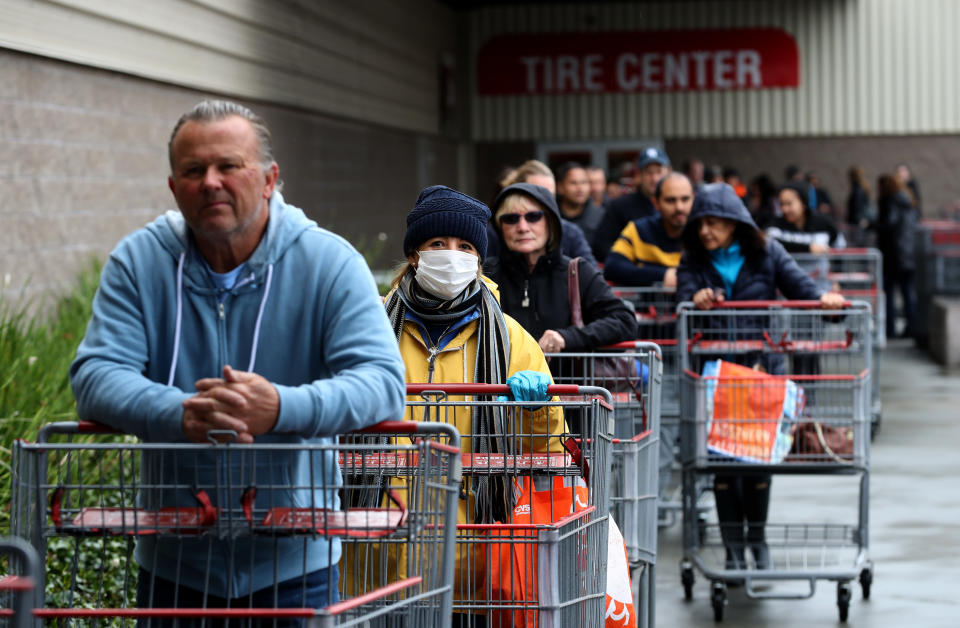Americans fear the coronavirus — but most aren't changing their behavior, poll finds
There is a wide disparity between beliefs and behavior when it comes to the novel coronavirus, despite public health experts, government officials, and business executives urging Americans to stay home. California’s Bay Area has mandated a “shelter in place” policy for some 7 million residents, which requires them to remain at home barring essential activities. New York City may be expected to follow suit.
Seventy-four percent of Americans are afraid of accidentally spreading the virus to vulnerable people even if they are asymptomatic, according to a new survey from Harris Poll. But they’re not changing their daily patterns to actually mitigate risk to other people, according to the survey of 2,050 U.S. adults between March 14 and March 15.

Eighty-nine percent of Americans are still going to coffee shops and 58% have not changed how often they’re inviting people over, according to the Harris Poll survey respondents, whose age, sex, race/ethnicity, education, region, and household income were weighted to bring them into line with their actual proportions of the U.S. population.
Half of respondents have not altered their hygiene behavior with house guests (e.g., asking friends and family to wash their hands immediately upon entering). As recently as this past weekend, social distancing has become ubiquitous in talk but not practice.
Footage of the beaches of Clearwater, Florida, nightlife on Bourbon Street and Chicago’s St. Patrick’s Day festivities show throngs of people socializing as if the situation were normal.
🚔 “Your actions are jeopardizing public health.” – New Orleans Police as they clear crowds from Bourbon Street. #coronavirus pic.twitter.com/Q2T0M5WrcC
— Brantly Keiek (@BrantlyWx) March 16, 2020
Still, since the first confirmed case of COVID-19 in the United States was reported on January 20, conditions have only escalated, with the virus reaching all 50 states and taking over 100 lives in the U.S.
‘The kerosene on the fire of the news cycle’
The unknown and unprecedented nature of the disease is stoking fear among Americans. Seventy-nine percent of respondents said drastic headlines about how society is changing is the No. 1 reason they are fearful. Seventy-eight percent said they are primarily scared because of the deluge of news about people fighting over products at the grocery store; 75% pointed to the constant stream of reactions to the outbreak on social media.
“It’s the kerosene on the fire of the news cycle. Every hour, some news event is coming out — that’s creating a lot of fear and anxiety among Americans. We’ve never had a crisis in America with the sophistication of social media in this participative way, amplifying fear. Social media can also amplify good news when it comes, but there doesn’t seem to be good news yet,” said John Gerzema, CEO of The Harris Poll.
The poll also found, unsurprisingly, that work is being disrupted to some degree for all Americans. The biggest changes workers have seen from their employers are postponing work travel and remote work. Eighteen percent of respondents said COVID-19 has decreased their productivity.
In light of store closures and reduced hours, those working in the service industry are hit the hardest, while tech and business workers benefit the most from “work from home” policies, which is not an option for many employees — across retail, hospitality, transportation and the like.
Adults with household income of at least $100,000 are three times more likely than families that make $50,000 or less to say they are working from home more often as a result of the coronavirus outbreak. Twenty-three percent of the affluent group say their employer has mandated a remote work policy compared to 13% of those in households making $50,000 or less.
Some employers are scrambling to implement policies to care for their employees amid such extenuating circumstances. Seventeen percent of adults whose households make $100,000 or more say their employer has explicitly offered to cover out-of-pocket healthcare costs for preventative care, (e.g., C19 testing, PCP visits), compared to six percent of those families making less than $50,000.
“This is a fluid situation. Some of us are caregivers, tutors, remote workers, daycare providers. And life has completely changed for many Americans,” Gerzema said. “There are big frustrations that their employers are lagging. Businesses have been caught flat footed. From the worker’s point of view, there hasn’t been a strong cadence of communication or demonstration of actual policies.”
________
Melody Hahm is Yahoo Finance’s west coast correspondent, covering entrepreneurship, technology and culture. Follow her on Twitter @melodyhahm.
Read more:
Land O’Lakes CEO: Rural America is the new inner city
Why neighborhood social network Nextdoor banned national politics
2020 candidates are ‘dumbfounded’ on how to solve homelessness: LA Mission CEO
How Disney and Apple are challenging Netflix’s binge-watching model
